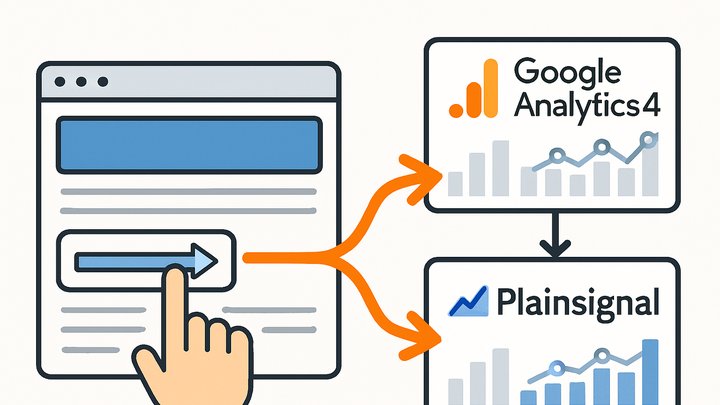Published on 2025-06-22T08:39:18Z
What is Outbound Link Tracking? Examples and Best Practices
Outbound link tracking in analytics monitors when users click on links that lead away from your site. It provides insights into how external resources, partners, or content contribute to user engagement and conversion paths. By sending click events to platforms like GA4 or cookie-free solutions such as PlainSignal, businesses can measure affiliate performance, referral traffic, and external interactions. Implementation commonly involves JavaScript event listeners or tag manager triggers that capture clicks and dispatch analytics calls before navigation. Proper setup ensures reliable data, helping teams optimize link placement, refine content strategies, and enhance overall user experience.
Outbound link tracking
Monitoring and analyzing when users click links that lead away from your site to measure external engagement and partnerships.
Why Outbound Link Tracking Matters
Understanding outbound link clicks can reveal user interests beyond your domain and highlight opportunities for partnerships, content optimization, and revenue generation. By measuring these interactions, you can assess which external links drive value and which need reassessment.
-
Understanding user behavior
Outbound clicks show what external resources users find valuable, helping tailor content and resources to their needs.
-
Measuring engagement and conversions
Track if affiliate or partner links lead to sign-ups, purchases, or other conversions by correlating click data with downstream events.
-
Optimizing external partnerships
Identify which collaborations or sponsorships perform best by analyzing click volumes and conversion rates on partner links.
How Outbound Link Tracking Works
Outbound link tracking typically uses JavaScript to capture click events on anchor tags, then sends those events to an analytics service before allowing navigation to continue.
-
Javascript event listeners
Attach click event handlers to
<a>elements, prevent default navigation, send the analytics event, and then resume navigation with a fallback timeout.-
Event binding
Use
document.querySelectorAll('a')andaddEventListener('click', ...)to monitor clicks. -
Delayed navigation
Delay link navigation briefly to ensure the analytics call is sent, or use the Beacon API for non-blocking requests.
-
-
Analytics platform integration
Connect outbound click handlers to your chosen analytics tool, mapping click data to the platform’s event schema.
-
GA4 configuration
Use
gtag('event', 'click', {...})or set up a trigger in Google Tag Manager for outbound clicks. -
PlainSignal setup
Include the PlainSignal script and rely on its auto tracking or use
PlainSignal('event', ...)for custom events.
-
Example Tracking Code
Code snippets for implementing outbound link tracking with PlainSignal and Google Analytics 4.
-
PlainSignal code example
<link rel="preconnect" href="//eu.plainsignal.com/" crossorigin /> <script defer data-do="yourwebsitedomain.com" data-id="0GQV1xmtzQQ" data-api="//eu.plainsignal.com" src="//cdn.plainsignal.com/plainsignal-min.js"></script> -
GA4 code example
gtag('event', 'click', { 'event_category': 'outbound', 'event_action': 'click', 'event_label': url });
Best Practices
Follow these guidelines to ensure accurate and actionable outbound link data.
-
Use clear event naming
Standardize event categories and labels, e.g.,
event_category: 'Outbound Link',event_action: 'click',event_label: URLfor consistency. -
Implement fallbacks
Use the Beacon API or a timeout-based fallback to prevent navigation from interrupting the analytics call.
-
Leverage tag managers
Use Google Tag Manager or similar tools to automate outbound link triggers and reduce manual code maintenance.
Common Pitfalls and Troubleshooting
Be aware of these common issues when tracking outbound links and how to address them.
-
Missed events due to fast navigation
Analytics requests can be cancelled if navigation happens too quickly; enable
transport: 'beacon'or add a small delay. -
Incorrect link selectors
Ensure your JavaScript or tag manager targets the correct CSS selectors, especially for dynamically generated links.
-
Cross-domain tracking conflicts
Configure domains properly in GA4 or your analytics tool to avoid link attribution issues when navigating between domains.
